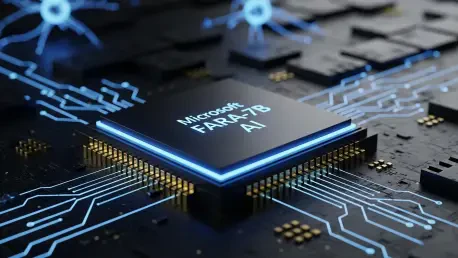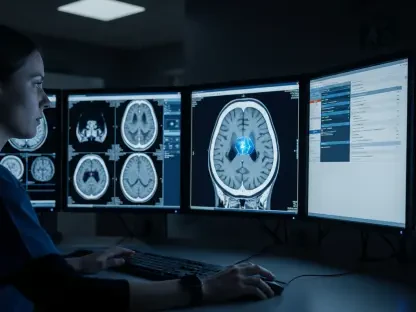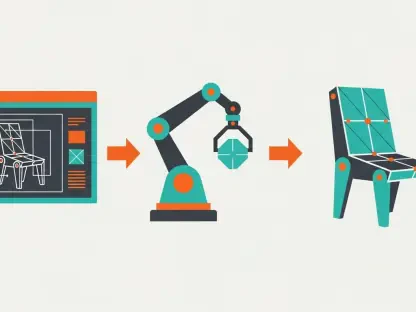Imagine a world where advanced AI operates directly on a personal computer, eliminating the need to send sensitive data to distant servers while still delivering top-tier performance, and Microsoft has turned this vision into reality with Fara-7B, a groundbreaking 7-billion parameter model designed as a Computer Use Agent (CUA). This compact powerhouse challenges industry giants by running locally, ensuring data privacy and user autonomy for both individuals and enterprises. With a focus on efficiency and security, Fara-7B is redefining how AI integrates into daily workflows, addressing long-standing concerns about data breaches and latency. Its unveiling marks a significant shift in the landscape of AI agents, promising a future where powerful tools are accessible without compromising control or safety. This exploration delves into the core strengths, innovative design, and forward-looking potential of Fara-7B, shedding light on why it stands out in a crowded field of technological advancements.
Unveiling Fara-7B’s Core Strengths
Privacy and Local Processing
Fara-7B sets itself apart by prioritizing on-device execution, a feature that directly tackles the growing anxiety over data security in the digital age. By operating locally on a user’s personal computer, this AI model ensures that sensitive information never leaves the device, a concept Microsoft refers to as “pixel sovereignty.” This approach is particularly vital for industries like healthcare and finance, where regulations such as HIPAA and GLBA impose strict standards on data handling. Enterprises can now leverage advanced automation without the looming risk of exposing confidential information to cloud-based vulnerabilities. The design not only fosters trust among users but also aligns seamlessly with compliance needs, positioning Fara-7B as a reliable solution for organizations navigating complex legal landscapes. This focus on privacy addresses a critical barrier to AI adoption in regulated sectors.
Moreover, the local processing capability of Fara-7B reduces dependency on constant internet connectivity, enhancing accessibility in environments with limited or unstable networks. This is a game-changer for remote workers or businesses in regions where cloud infrastructure isn’t always reliable. Latency issues, often a drawback of cloud-dependent models, are minimized as all computations occur directly on the device. Such efficiency allows for real-time responses, crucial for time-sensitive tasks in professional settings. Beyond technical advantages, this setup empowers users with a sense of ownership over their data, reinforcing the model’s appeal to those wary of external breaches. Microsoft’s commitment to keeping data confined to the user’s hardware reflects a broader industry trend toward prioritizing security without sacrificing functionality, making Fara-7B a timely innovation in AI deployment.
Efficiency in Performance
When it comes to raw performance, Fara-7B punches well above its weight, proving that bigger isn’t always better in the realm of AI models. Despite its modest size of 7 billion parameters, it achieves an impressive 73.5% success rate on the WebVoyager benchmark, surpassing larger competitors like GPT-4o, which scores 65.1%. This metric highlights the model’s ability to handle complex tasks with precision, making it a standout in a field often dominated by resource-heavy systems. The compact design doesn’t just save on computational power; it democratizes access to high-performing AI for users without access to extensive hardware. Such efficiency is a testament to Microsoft’s focus on optimizing intelligence over sheer scale, setting a new standard for what smaller models can achieve.
Equally striking is Fara-7B’s ability to streamline task completion, averaging just 16 steps compared to 41 for similar models. This efficiency translates to faster outcomes, a critical factor for productivity in both individual and enterprise settings. Whether automating repetitive web-based tasks or navigating intricate user interfaces, the model minimizes unnecessary actions, delivering results with remarkable speed. This not only saves time but also reduces the cognitive load on users who might otherwise need to intervene in lengthy processes. The cost-accuracy tradeoff demonstrated by Fara-7B makes it an attractive option for organizations seeking powerful tools without the overhead of massive infrastructure. Its performance underscores a shift in AI development toward smarter, leaner solutions that prioritize practical impact over bloated specifications.
Innovative Design and Interaction
Visual-First Navigation
One of Fara-7B’s most distinctive features is its visual-first approach to interacting with web interfaces, a method that mirrors human behavior in a strikingly intuitive way. Unlike traditional AI agents that depend on accessibility trees or underlying code structures, this model relies solely on pixel-level data derived from screenshots. By interpreting visual cues, it navigates websites using familiar actions like mouse clicks, keyboard inputs, and scrolling, even when the backend code is complex or obscured. This flexibility allows Fara-7B to adapt to a wide range of digital environments, making it exceptionally versatile for tasks that require interaction with dynamic or non-standard interfaces. Such innovation broadens the scope of automation possibilities, pushing beyond the limitations of code-dependent systems.
This visual-first strategy also enhances the model’s privacy focus by avoiding reliance on external data structures that might expose sensitive information. Since all processing happens at the pixel level on the user’s device, there’s no need to access or interpret underlying website code, further reducing potential security risks. The approach proves particularly effective in scenarios where web designs are unconventional or frequently updated, as Fara-7B doesn’t require predefined pathways to function. Users benefit from a system that operates much like they do, interpreting on-screen elements in real time without needing deep technical integration. Microsoft’s emphasis on this human-like interaction method not only showcases technical ingenuity but also sets a precedent for how AI can adapt to the visual language of modern computing, opening doors to more natural digital experiences.
User Control and Risk Mitigation
Fara-7B strikes a careful balance between automation and human oversight, embedding safeguards that prioritize user trust and safety in every interaction. A key feature, known as “Critical Points,” ensures the model pauses at pivotal moments—such as sending an email or finalizing a transaction—to seek explicit user consent before proceeding. This mechanism mitigates the risk of errors or unintended actions, a common concern with autonomous AI systems prone to occasional misjudgments or hallucinations. By involving users at these decisive junctures, Microsoft fosters confidence in the technology, ensuring that significant outcomes remain under human control. This thoughtful design addresses a fundamental challenge in AI deployment: maintaining autonomy without compromising accountability.
Complementing these safeguards is the integration with Magentic-UI, a research prototype interface crafted to facilitate seamless interaction between humans and the AI agent. This tool provides intuitive opportunities for intervention, allowing users to step in without feeling overwhelmed by constant prompts. The interface aims to smooth out the user experience, avoiding frustration that might arise from excessive approval requests while still preserving essential oversight. Balancing these elements remains a nuanced challenge, as too many interruptions could disrupt workflow efficiency. Nevertheless, Magentic-UI represents a step toward refining how AI and humans collaborate, ensuring that Fara-7B’s automation enhances productivity without overstepping boundaries. Such features underscore Microsoft’s commitment to building trust in AI systems through deliberate risk management.
Training and Future Potential
Cutting-Edge Development Process
The creation of Fara-7B reflects Microsoft’s innovative approach to AI training, leveraging a synthetic data pipeline that sets it apart from conventional methods. This process involved a multi-agent framework called Magentic-One, where an “Orchestrator” agent devised strategic plans, and a “WebSurfer” agent executed web navigation tasks. Together, they generated 145,000 successful task trajectories, which were then distilled into Fara-7B through supervised fine-tuning. Built on the Qwen2.5-VL-7B base model, it boasts a long context window of up to 128,000 tokens and strong visual-text alignment, enabling precise connections between instructions and on-screen elements. This meticulous development strategy showcases how complex behaviors can be compressed into a compact, efficient model without losing effectiveness, highlighting a significant leap in knowledge distillation.
Beyond the technical framework, the training methodology emphasizes adaptability, ensuring Fara-7B can handle diverse tasks with minimal resource demands. The synthetic data approach allowed Microsoft to simulate real-world scenarios at scale, refining the model’s ability to navigate intricate digital environments. This not only accelerates development but also reduces reliance on vast, real-world datasets that might raise privacy concerns. The result is a system that performs with precision while maintaining a small footprint, ideal for deployment on standard hardware. Such ingenuity in training reflects a broader industry shift toward smarter, more sustainable AI solutions, where the focus lies on optimizing intelligence rather than expanding model size. Fara-7B’s development process stands as a blueprint for future advancements in accessible technology.
Path to Continuous Improvement
Looking ahead, Microsoft has ambitious plans to elevate Fara-7B’s capabilities without increasing its compact size, focusing on intelligence over scale. Future iterations will explore reinforcement learning within sandboxed environments, allowing the model to learn in real time from trial and error. This method promises to enhance adaptability, enabling Fara-7B to refine its responses based on dynamic user interactions without compromising safety. Currently available on platforms like Hugging Face and Microsoft Foundry under an MIT license, the model invites experimentation and prototyping, though it’s not yet deemed ready for mission-critical applications. This open approach encourages community input, fostering iterative improvements that could shape its evolution into a more robust tool.
Additionally, the emphasis on real-time learning signals a commitment to addressing the inherent limitations of static AI models, such as occasional errors or outdated responses. By integrating continuous feedback loops in controlled settings, Microsoft aims to bolster Fara-7B’s accuracy and reliability over time. The focus on maintaining a lean structure ensures that enhancements won’t burden users with higher hardware demands, preserving accessibility. As these advancements unfold, the model could redefine how AI agents integrate into personal and professional workflows, balancing cutting-edge performance with practical deployment. Reflecting on the journey so far, Fara-7B’s development marked a pivotal moment in prioritizing privacy and efficiency, and its future trajectory holds promise for even greater impact through thoughtful, user-centric innovation.









